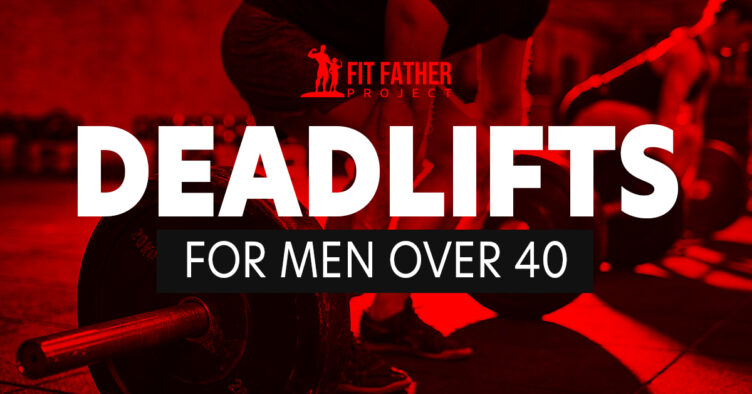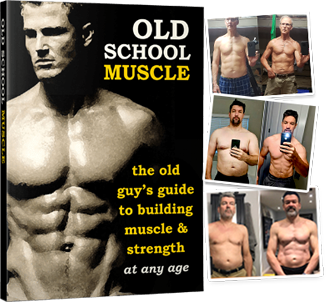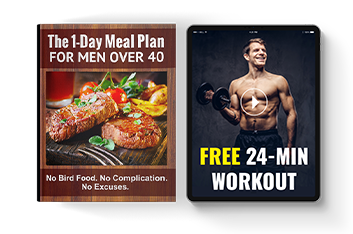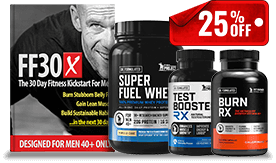The deadlift is a great strength training move that targets a number of muscle groups at once. But what are the best deadlifts for men over 40?
Working out as you get older is important for so many reasons. Weight lifting increases strength, improves endurance, and promotes healthy living. Plus, it builds lean muscle mass, which improves your body composition and increases your calorie-burning potential.
As men age, lean body mass decreases, something known as sarcopenia. Lifting weights is essential if you want to maintain muscle mass.
And one of the best weight-lifting exercises you can do is the deadlift. Deadlifts strengthen the hamstrings, glutes, and quads while also activating muscles in the core, upper back, and deltoids.
There are several different deadlifts for men over 40 that target your muscle groups from different angles, giving you a way to utilize different types of deadlifts to work your entire lower body.
In addition, you can use different types of equipment for deadlifts. For example, using a conventional bar to perform a deadlift is a great way to challenge yourself with more weight, as these bars are typically heavier than dumbbell or kettlebell variations.
However, other variations, like dumbbell deadlifts, have other advantages. For one, you can do deadlifts even if you don’t have a barbell or weight plates. Plus, if you have low back issues, you can modify deadlifts and use a hex bar or dumbbells to take pressure off of your lumbar spine and avoid injuries.
Keep reading to learn some awesome deadlifts for men over 40 and spice up your lower body workouts!
Learn more about the importance of strength training and how you should be working out in your 40s, 50s, 60s, and beyond!
The Best Deadlifts For Men Over 40
Conventional Barbell Deadlifts
The deadlift is a great exercise that works a number of muscles at once, making it ideal to include in a full-body workout.
As mentioned above, the deadlift targets the hamstrings, glutes, quads, core, upper back, and deltoids.
- Stand with your feet hip-width apart and mid-foot under the barbell.
- Hinge forward at your hips and grasp the bar with your hands just outside of your knees.
- Take the slack out of the bar by slightly pulling up on the bar until it makes contact with the weights on the ends.
- Then drive your heels into the floor and explode up by using your legs until you’re standing with your hips fully extended.
- As you come up, be sure to pull the bar up close to your shins.
- Then return the bar to the floor by slowly moving your hips back while bending your legs and lowering the bar.
- While you are technically pulling the bar up off the ground, make sure you are initiating this movement by contracting your glutes and hamstrings and pushing off the floor.
- Lower the bar to the floor and repeat.
- Aim for three sets of 8-10 reps.
Your lower back must stay neutral to avoid injury. Rounding it during deadlifts puts you at risk of injuring your back. Focus on form, not weight, when you first start doing this movement to avoid injury. Gradually increase your weight as you perfect your form and gain strength.
Check out this tutorial on deadlifting for beginners!
Sumo Deadlifts
Your form here will be similar to a traditional deadlift, except you will stand with your legs wider than shoulder-width distance with your feet turned out slightly. You may need to use a lighter weight than with a traditional deadlift because you're adding arm work into it.
Unlike a traditional deadlift, where the weight begins on the floor, in this deadlift, the move starts with you standing while holding the weight. This targets your hamstrings and glutes to a greater degree than standard deadlifts.
Sumo deadlifts are also a great option if you have lower back issues. For example, one study found that the erector spinae, a group of back stabilizing muscles in the low back, were less activated when performing sumo deadlifts when compared with a traditional deadlift.
- Stand with your feet hip-width apart while holding a barbell or (dumbbell in each hand) in front of your thighs.
- Hinge forward at the hips and lower the dumbbells in front of your shins, keeping them close to your body.
- Once the weights go past your knees, drive through your heels to extend your hips and knees and return to a standing position.
- Aim for three sets of 10-12 reps.
How does the sumo deadlift compare to the conventional variation?
Stiff-Legged Deadlifts
Similar to the sumo deadlift, the stiff-legged deadlift puts more emphasis on the hamstrings than a conventional deadlift. In addition, stiff-legged deadlifts tend to work the lower back muscles to a greater degree.
The stiff-leg deadlift, as you might expect, involves less bending of the knee and so increases the work the glutes have to do along with the hamstring.
- Stand with your feet shoulder-width apart, holding a barbell in an overhand grip (palms facing you).
- Bend at your hips and lower the barbell, keeping your back straight.
- Lower until you feel the stretch in your hamstrings and glutes, and then slowly reverse the move to stand back up.
- Keep the bar close to your body throughout the exercise.
This deadlift may seem very similar to a sumo deadlift — and it is! However, when performing the sumo deadlift, you should have your knees fixed in a bent position. This gives you more range of motion and engages the lower back and hamstrings to a lesser extent.
On the other hand, with the stiff-legged deadlift, you are in a fully extended position at the start and should only let the knees slightly bend to the point at which hamstring and lower back tension are at maximum. This will put more emphasis on the hamstring and lower back.
Learn the proper dumbbell deadlift technique to get the most out of your workout.
Single-Leg Deadlifts With Dumbbells
Single-leg exercises are a great way to focus on any muscle imbalances between your right and left sides. The single-leg deadlift will force you to engage all of your muscles on each side in isolation, so you can’t compensate for weaknesses with the contralateral side.
- Stand with your feet hip-width apart while you hold a dumbbell in each hand with your palms facing the front of your legs.
- Hinge forward at your hips as you lift your left leg behind you.
- Your body should be parallel to the floor from your head to your left foot with the dumbbells hanging down.
- Then engage your glutes and hamstring to come back to the standing position.
- Aim for 10-12 reps.
- Then switch sides and repeat.
Kettlebells are another piece of exercise equipment that can be utilized to perform deadlifts.
- Stand with your feet hip-width apart, knees slightly bent as you hold a kettlebell in front of your thighs.
- Hinge at your hips and push your butt back as you lower your torso and the weight toward the ground.
- Keep your back flat and shoulders back. Your torso should be almost parallel to the floor at the bottom of the movement.
- Then push through your heels to stand up straight as you keep your core engaged.
- Pause at the top and squeeze your glutes.
- Then repeat for 8-10 reps.
Learn how to do a single-leg Romanian deadlift with dumbbells.
Hex Bar Deadlifts
A hex bar is a hexagon-shaped bar that you stand in the middle of. It’s sometimes also referred to as a “trap bar” since many weight lifters do shrugs using this bar as well.
Using a hex bar for deadlifts is a great option for guys with lower back issues or who want to avoid putting too much stress on the lumbar spine. Not only this but using a hex bar can actually help you generate more power.
For instance, a study from the Journal of Strength and Conditioning Research found that when test weight lifters performed a hex bar deadlift, they were able to lift a heavier one rep max than when they performed a traditional barbell deadlift. In addition, the lifters produced significantly greater peak force, peak velocity, and peak power values.
This study also demonstrated that the hex bar deadlift placed less stress on the lower back.
- For the hex bar deadlift, stand in the center of the hex bar with your feet hip-width apart.
- Hinge at your hips as you grab the handles of the hex bar.
- Raise your hips up slightly, keeping your back flat, to create tension in the back of your legs as you would with a traditional deadlift.
- Drive your heels through the ground as you stand straight up and extend your hips.
- Squeeze your glutes at the top of the lift.
- Lower the weight to the ground slowly.
- Repeat for 8-10 reps.
Holly is board-certified in nephrology and internal medicine, has a bachelor’s degree in dietetics, and is a certified personal trainer with NASM-PES certification. Holly is a keen runner, triathlete, and fitness and nutrition enthusiast. She has completed four full ironmans, twelve marathons, countless half ironmans, Olympic distance triathlons, half marathons, and numerous other road races. Holly joined the Fit Father Project in May 2019 as a regular writer, contributing articles on health, wellness, exercise, and nutrition.![]()
Holly Smith, M.D., B.S. Dietetics, NASM-PES Certified Trainer
Writer, Fit Father Project
This proven "Old School Muscle Program For Guys 40+" combines the “old school” bodybuilding secrets with the “new school” science… to produce muscle & strength building results fast. Only for guys 40+ who want to build muscle. If you're frustrated with stubborn belly fat, failed diets, and time-consuming workouts, this is the answer you’ve been looking for…Here’s How Busy Guys 40+ Are Building Age-Defying Muscle And Strength… Working Out Just 3 Hours Per Week...
See the Old School Muscle (OSM) Program overview here. You’ll discover how this proven program has helped thousands of guys 40+ pack onage-defying muscle and strength – the smart & sustainable way. »
*Please know that weight loss results & health changes/improvements vary from individual to individual; you may not achieve similar results. Always consult with your doctor before making health decisions. This is not medical advice – simply very well-researched info on deadlifts for men over 40.












